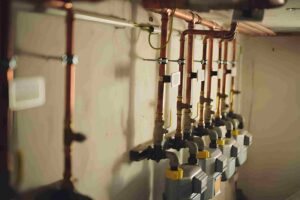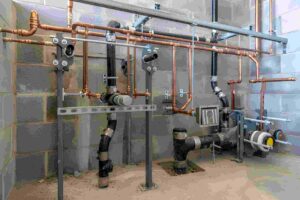What Is Rough-In Plumbing and How Does It Work?
Introduction
When constructing or renovating a home, one of the most critical steps before finishing walls and floors is Rough in Plumbing. During this step, the structure’s pipes, drains, and water lines are laid out. If you do it right, it makes sure that water flows smoothly, drains properly, and meets building codes.
Rough in Plumbing is the “skeleton” of your plumbing system. It’s everything that goes on behind the walls before you see the fancy taps and fixtures. Knowing how this step works helps homes avoid mistakes that cost a lot of money and makes sure that the final installation goes more smoothly.
What Is Rough-In Plumbing?
Rough-in plumbing means putting in water lines, drain pipes and venting systems before the final finishes, plasterboard and floors are put down. Plumbers plan out how water will enter and leave your home during this first stage of setup.
In general, this process includes:
- Setting up the main lines for water and drains
- Putting in vent stacks to control air pressure
- Getting the base ready for things like toilets, sinks, and showers
- Making sure the slope and placement are right for gravity-fed drainage
Basically, the invisible but important part of plumbing that affects how well your system will work when everything is done.

Why Rough-In Plumbing Is So Important
Doing a good job with the Rough in Plumbing stage can save you a lot of money on fixes later on. Pipes that aren’t put in properly can leak, overflow, or not have enough water pressure.
This is why it’s important:
- Prevents Future Leaks: Ensures that the pipes are properly connected and sealed.
- Maintains Water Pressure: The right pipe size ensures even spread of water.
- Supports Drainage Efficiency: Slow sinks and gurgling sounds can be avoided with the right venting.
- Ensures Code Compliance: Placement, material, and slope angles are all controlled by local plumbing rules.
One example is a vent system that doesn’t work right can cause smells or draining problems. Read our in-depth guide on plumbing air pipes to learn more about this.
Phases of Rough-In Plumbing
There are three main stages of rough-in work, and each one needs skill and attention to detail.
1. Water Supply Rough-In
In this step, the lines that bring clean water to your fixtures are laid. Materials like copper, PEX, or CPVC are often used. To keep water flow at multiple fixtures, each line must be the right size.
2. Drain-Waste-Vent (DWV) Rough-In
This system gets rid of waste water and keeps sewer gases from getting into your house. It’s very important to make sure there is enough ventilation, especially in bathrooms, kitchens, and wash rooms.
3. Fixture Layout
Finally, plumbers mark where sinks, tubs, toilets, and other items will go in the future. Before the walls are closed, these places are checked to make sure they are accessible and follow the rules.
Rough-In vs. Finish Plumbing
Many homeowners confuse Rough in Plumbing with finish plumbing. The key difference lies in timing and visibility.
| Stage | Description | Visibility |
| Rough-In | Pipes, vents, and drains are installed within walls and floors. | Hidden |
| Finish Plumbing | Fixtures like faucets, toilets, and showers are connected and visible. | Visible |
To put it simply, Rough-In builds the system and Finishing brings it to life.
Common Materials Used in Rough-In Plumbing
- PEX (Cross-linked Polyethylene): It’s bendable, simple to put in place, and won’t rust.
- Copper: Ideal for both hot and cold water because it is strong and doesn’t melt.
- PVC: Often used for vent, drain, and waste lines.
- ABS (Acrylonitrile Butadiene Styrene): Pipe made of strong plastic that is often used in DWV systems.
If your house was built many years ago, it may still have old systems like polybutylene lines that need to be replaced when the house is renovated.
How Long Does Rough-In Plumbing Take?
How long it takes depends on how big and hard the job is.
- New homes: Three to five days
- Small renovations: Within two days
- Commercial buildings: It might take weeks.
The schedule is also affected by things like getting building permits, going through inspections, and working with electricians or HVAC experts.
Cost Factors of Rough-In Plumbing
Several things can change the cost of Rough-In:
- Size and plan of the home
- Home’s bathroom and kitchen countHome’s bathroom and kitchen count
- What kind of pipes are used
- Being able to get into crawl areas or walls
- Prices for labour and water rules in your area
Talk to a neighbourhood plumber to get an accurate quote. You can read about average prices for installation and replacement in guides like “plumber cost to replace your garbage disposal.”
Inspections and Building Codes
Every Rough-In work has to follow the rules set by the local plumbing department. Before the walls are sealed but after the pipes are put in, a tester makes sure:
- Right pipe slopes
- The right vent links
- Joints that don’t leak
- How far apart water and power lines should be
A failed inspection can delay a job, so only hire licensed experts.

Bathroom and kitchen plumbing that is already roughed in
It’s important to plan ahead for bathrooms and kitchens because they have a lot of water sources and drains.
Bathroom Rough-In:
Includes installation for toilets showers bathtubs and sinks. Correct pipe slopes prevent standing water and odor problems.
Kitchen Rough-In:
Mostly talks about washbasin drains, dishwasher lines and water hookups for refrigerators. Learn some DIY plumbing tips for your kitchen sink and bathroom to handle small upgrades after Rough-In.
Troubleshooting Common Rough-In Issues
- Incorrect Slope or Alignment: Slows down flow.
- Improper Venting: Leads to the smell of sewer gas.
- Leaks at Joints: Usually due to poor soldering or loose fittings.
- Clogs in Drain Lines: Can occur if debris enters pipes before sealing.
For extensive repairs a commercial plumber or residential expert can identify and fix issues efficiently.
Safety and Best Practices
- Use high-quality pipe materials.
- Always follow the bathroom rules in your area.
- Set up checks before putting up the plasterboard.
- Label all the ends of the pipes so they are easy to find.
- Keep work zones clear to avoid damaging pipes.
If you have problems later, calling a plumber in Lawrenceville can make sure that the fixes are done quickly and correctly.
Conclusion
Rough-in plumbing is the basis of a plumbing system that works and is effective. Before the finishing touches are added it plans the structure for water supply drainage and air flow. Planning ahead having a professional install it and following building codes will make sure that your system works well for many years.
This stage needs accuracy and skill for everything from putting in drain pipes and vent stacks to checking and placing fixtures. Putting money into skilled workers now can save you a lot of trouble tomorrow.
Also don’t forget to honour plumbers on National Hug a Plumber Day if you care about the hard work they do behind the walls.
FAQs About Rough-In Plumbing
Q1. When you rough in plumbing, what does that mean?
Rough-in plumbing is the first part of installing plumbing. During this step, all the water supply lines, drain pipes, and vent pipes are put out but not yet connected to fixtures. It’s the stage before the floors and walls are put together.
Q2. What is included in rough-in plumbing?
Rough-in plumbing includes the installation of pipes for water supply, drainage, venting, and waste disposal. It sets the groundwork for future connections to sinks, toilets, bathtubs, and other fixtures.
Q3. The rough-in process takes how long?
Rough-in plumbing can take anywhere from two to five days, based on the size of the building, how complicated the layout is, and how easy it is to get to the pipe routes. It might take longer for big homes or buildings with many units.
Q4. What’s the difference between finish plumbing and rough plumbing?
Finish plumbing is the process of attaching obvious fixtures like faucets toilets and drains after building is almost finished. Rough-in plumbing is the process of installing the hidden pipes inside walls and floors.
Q5. How much does it cost to put in plumbing?
Pipes that are roughed in usually cost $7 to $15 per square foot which is $4000 to $10,000 for a normal home. Costs depend on the materials used the rate of labour and how complicated the plan is.